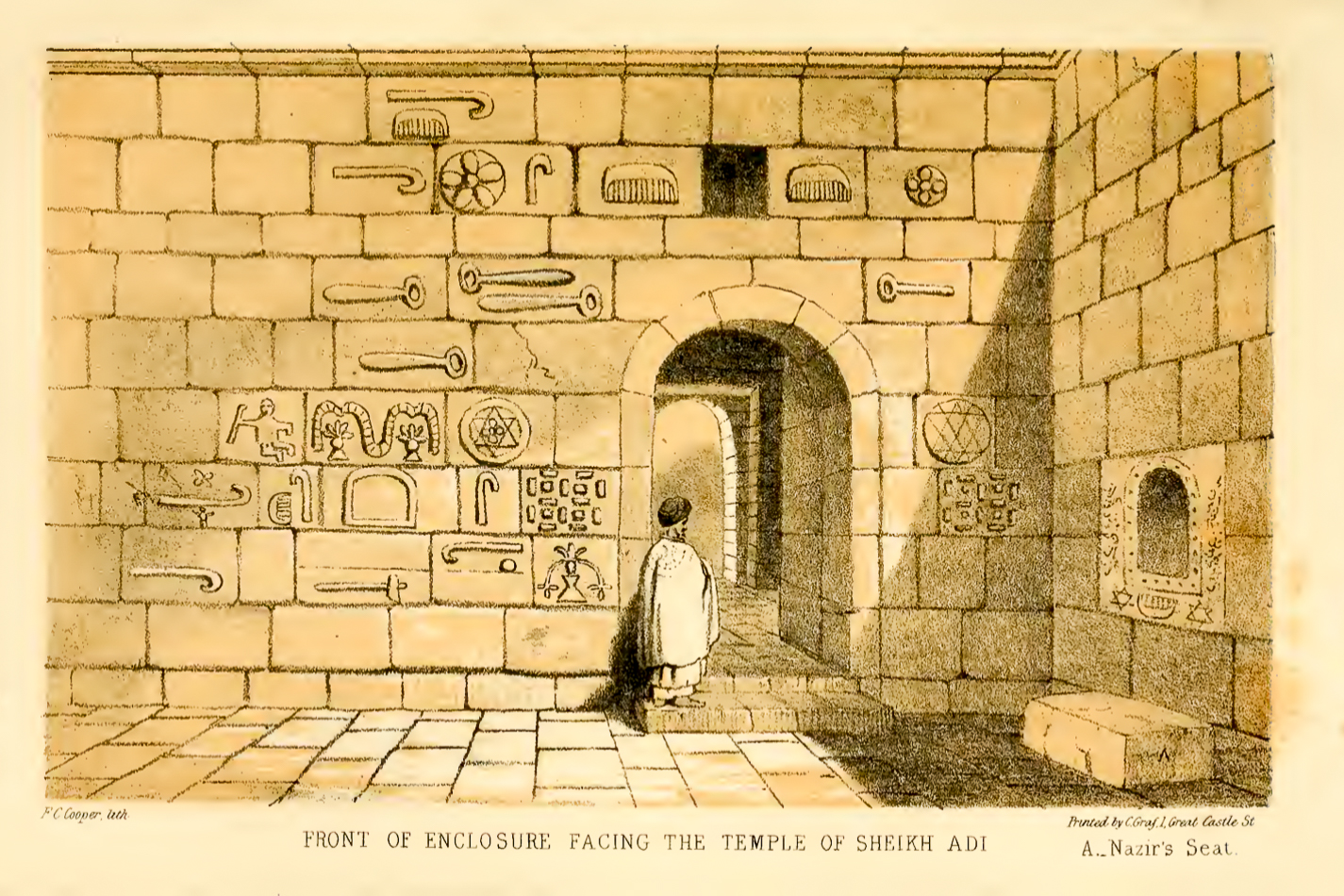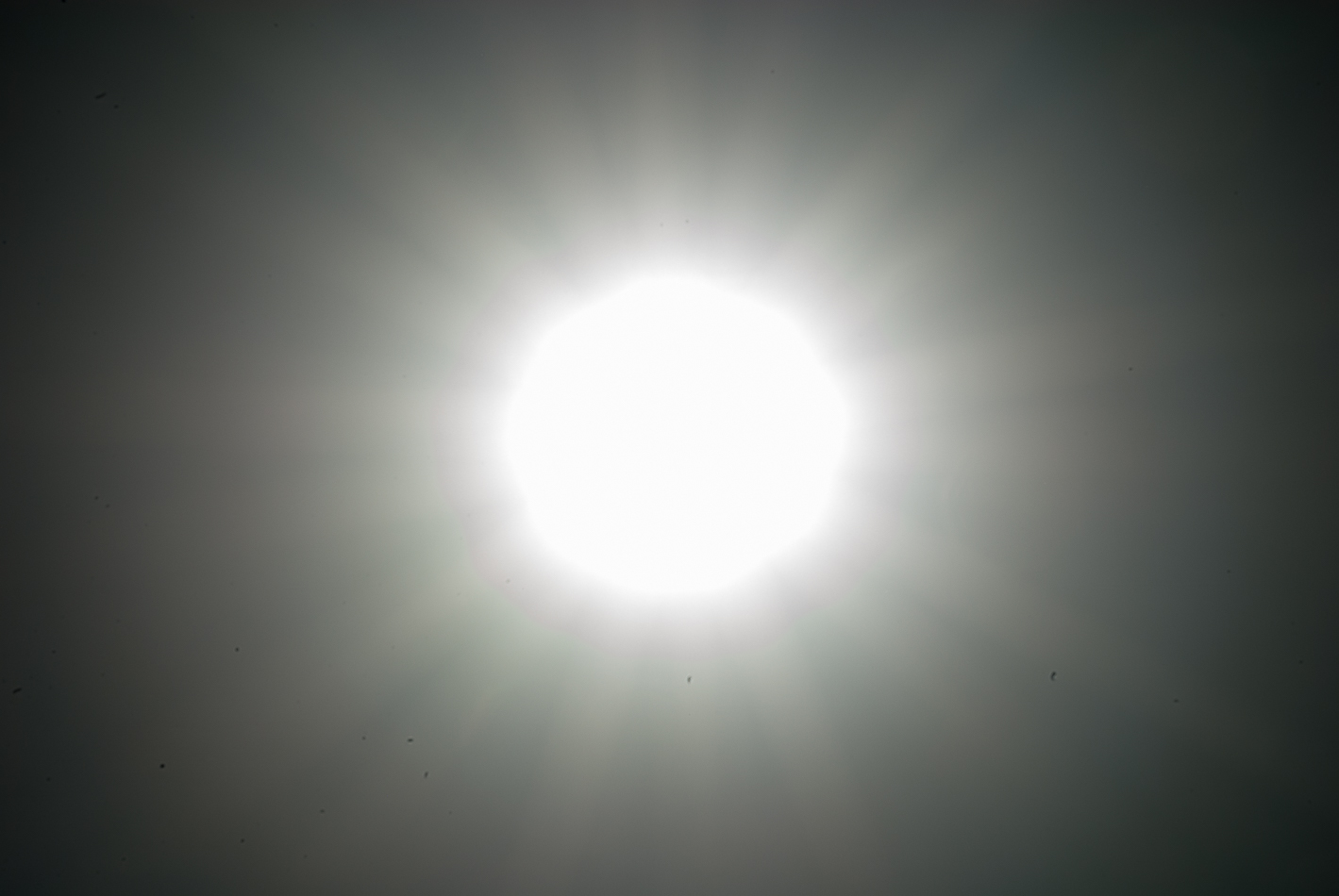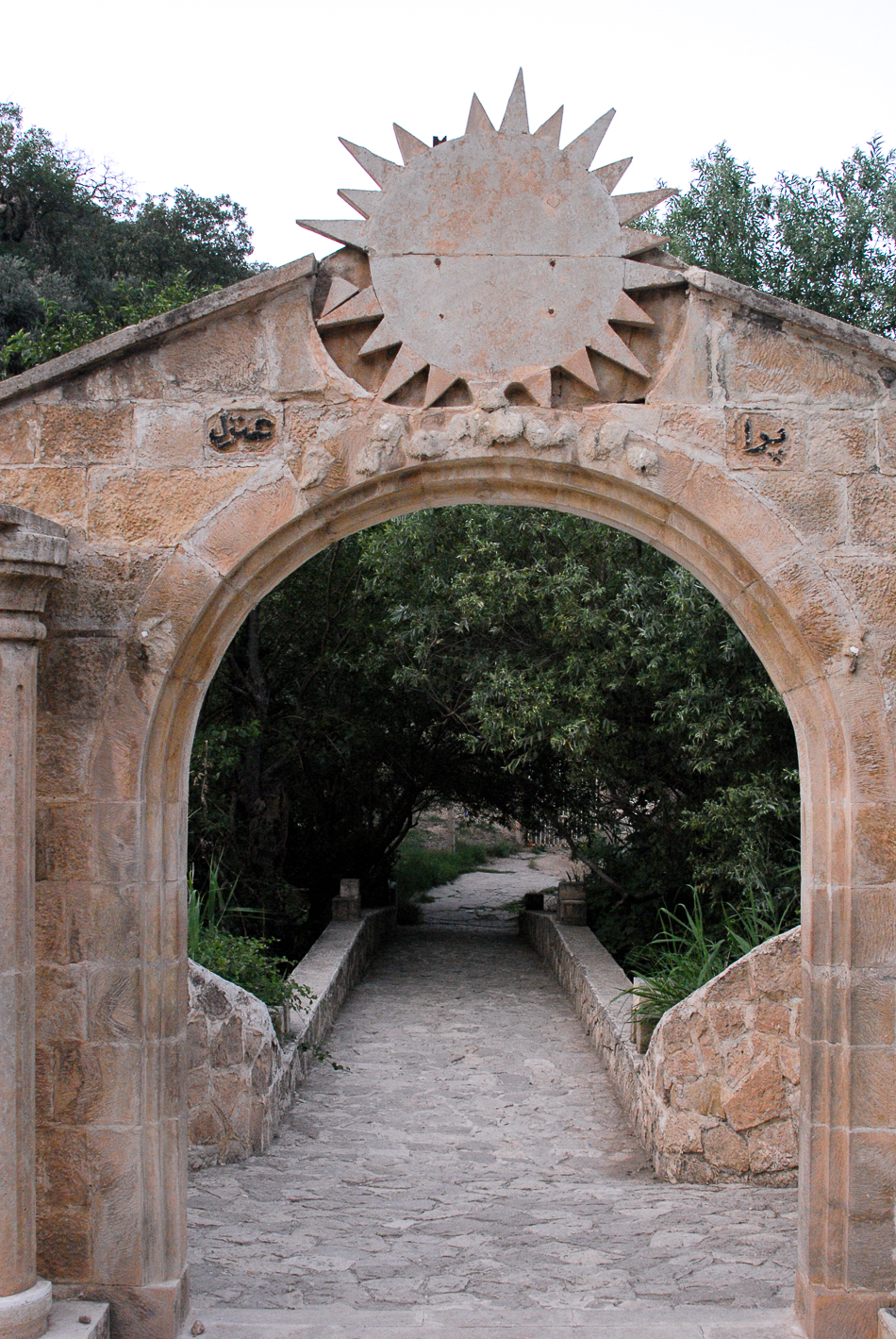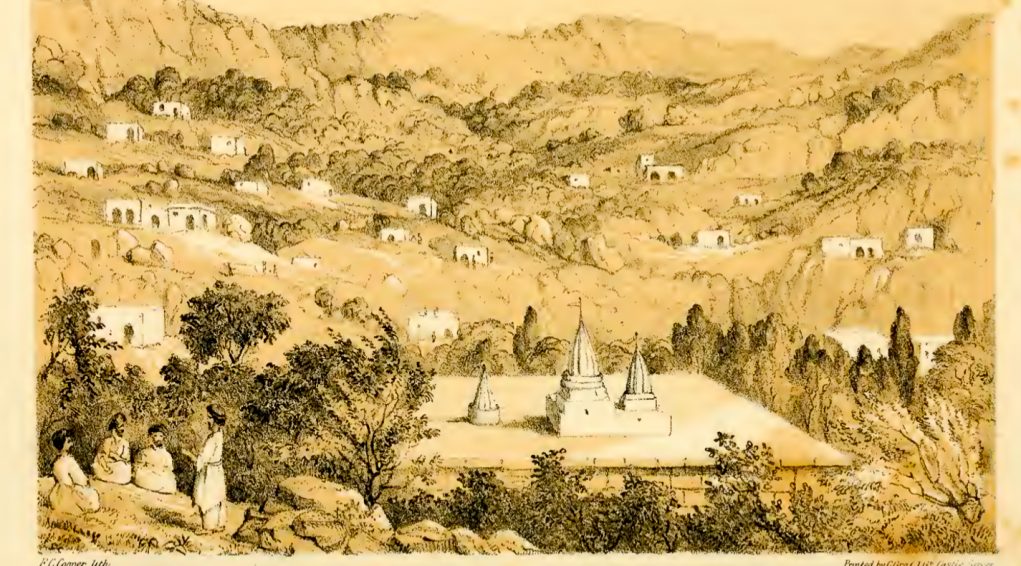The Yazidi Mausoleum of Baba Noah in Hatra
The Yazidi mausoleum Baba Noah in Hatra is located at 36°39’52.85″N 43° 2’38.04″E and 386 metres altitude in the Nineveh province, close to the major Christian city of Alqosh.

The village of Hatra was the largest village in the region, even in Iraq, and is no doubt one of the most ancient. One of the tells in Hatra testifies to this ancient heritage from the Assyrian period and the passage of Alexander the Great.
In 2014, before ISIS there were 11,800 inhabitants in Hatra. The devastation wrought by the Islamicist group forced the Yazidi out of their villages. 6,000 inhabitants emigrated to Europe. In 2018, there were only 6,000 inhabitants left in Hatra.
The Baba Noah mausoleum in Hatra is dedicated to one of the most venerable figures of Yazidism. God’s Prophet and the saviour of humanity, Noah occupies second place in the Yazidi pantheon after Adam.
Pic: The Yazidi mausoleum of Baba Noah in Hatra. June 2018 © Pascal Maguesyan / MESOPOTAMIA
About this file
The content of this file has been drafted by Dr. Birgül Açıkyıldız-Şengül, art historian, specialised in Yazidi heritage and culture. Dr. Birgül Açıkyıldız-Şengül is an associate researcher at the University Paul Valéry Montpellier III and the IFEA Istanbul, and is the author of a doctoral thesis: “Yazidi heritage: Funeral architecture and sculptures in Iraq, Turkey and Armenia” presented in 2006 at the University Paris I Panthéon-Sorbonne (department of Islamic art and archaeology). This thesis contains a documented inventory of 88 monuments (sanctuaries, mausoleums, baptistries, oratories, caravanserai, bridges and caves) and 60 funeral sculptures (in the shape of horses, rams, sheep or lions) in northern Iraq, Turkey and Armenia. Thesis published by I.B.Tauris (London, New York), 2010. The text has been enriched with the observations and interviews of the Mesopotamia team (Pascal Maguesyan, Shahad al Khouri, Sibylle Delaître (KTO)) with support from Mero Khudeada.
Location
The Yazidi mausoleum of Baba Noah in Hatra is located at 36°39’52.85″N 43° 2’38.04″E and 386 metres altitude.
Five kilometres to the east of the Mosul dam on the Tigris, the village of Hatra is located 15 km to the south of the major Christian city of Alqosh, 43 km north of Mosul and 50 km to the west of Lalish.
About the Yazidi in Iraq
Mainly settled in the autonomous region of Iraqi Kurdistan and the Nineveh plain, their geographic birthplace, there are also Yazidi in Turkey, Syria, and the Caucasus in particular in Armenia and Georgia. Generally considered as non-Islamic Kurds, which is at the very a least a simplistic if not inaccurate statement given their mythological origins, often demonised due to their religious practices, the Yazidi are a community whose historical origins and number are difficult to estimate.
Marginalized to the extreme in Iraq under various regimes, their existence was practically denied. Prior to 2003, Baghdad officially only recognised a few thousand whereas in reality there were no doubt closer to hundreds of thousands.
The conditions for an attempted genocide were already in place even before the ISIS jihadis started to massacre and kidnap Yazidi in the Sinjar mountains and province of Nineveh in August 2014.
Although the Iraqi forces and the coalition of resistance groups took back Sinjar in November 2015, the majority of the 500,000 – 600,000 Iraqi Yazidi are still displaced. The persecution they have suffered makes them fear for the future despite the constitutional guarantees afforded to them in 2005.
The territorial roots of Yazidism
Yazidism was founded in a mountainous territory where its inhabitants were protected by the slopes, peaks and caves. Considered sacred by the Yazidi, this territory roughly divides into two distinct regions, east and west of the Tigris, the key Mesopotamian river. To the west is Sinjar: the city, surrounding villages and the mountain range. To the east is the spiritual centre of Lalish, and the key sectors of Shekhan, Bozan, Bashiqa and Bahzani. The vast majority of the Yazidi population (including clergy) are from these regions although there are some scattered Yazidi communities outside of these areas.
For centuries, the Yazidi have preserved their customs and traditions in this region, this territory. This preservation of the past was cruelly undermined to the west of the Tigris in the Sinjar region by the devastating ISIS offensive in August 2014. The extent of the destruction and severity of the genocidal crimes committed severely weakened the Yazidi communities in the Sinjar mountains who previously formed the core of the Iraqi Yazidi population.
Territory, history and heritage
It is in this region, either side of the Tigris, that the Yazidi were able to preserve and develop the characteristic architectural features of their religious buildings which are the main places of worship for the Yazidi faithful.
These buildings are mostly dedicated to the first disciples of the 12th century Yazidi reformer, Sheikh ‘Adî, members of the Chamsani families and families such as Hasan Maman, Memê Rech and Cerwan, as well as the community’s first religious leaders, descendants of Sheikh ‘Adî (members of the Adani family) and certain important Sufi mystics who influenced Sheikh ‘Adî’s teachings, namely Abd al-Qadîr al-Jilani, al-Hallaj et Qedib al-Ban (Qadî Bilban).
However, it would be wrong to conclude that Yazidism is a medieval religion. The paucity of the theological and historical sources available is compensated for by the ancient tradition and mythology which are omnipresent and constantly developing. The Yazidi see Noah as one of their most ancient and most illustrious patriarchs. They even claim that he lived in Iraqi Mesopotamia, in Ain Sifni (Shekhan) where he built his ark. The Yazidi historians claim that “the Yazidi religion is very ancient. It goes back to 3,500 years BC.”[1]
The Yazidi have a wide diversity of places of worship and prayer, including cemeteries, mausoleums (mazar) some of which are larger than others (khas / mêr), fire oratories (nîshan), the houses of Sheikh or Pîr, trees, bushes, olive groves, bridges, arches, caves, sacred stones (kevir), springs etc. These monuments, structure and sites dedicated to the Yazidi “saints” constitute a large proportion of the cultural setting of the Yazidi communities and are the tangible, physical manifestation of the Yazidi belief system as a whole.
There is however, one fundamental place which all Yazidi turn to, including the diaspora: the Lalish valley in Iraqi Kurdistan. It is the most sacred place in Yazidism. It is the location of the sanctuary of Sheikh ‘Adî, the great reformer of Yazidism in the 12th century. This valley, its mausoleums and its environment are the centre of gravity of Yazidi spiritual life.
The Yazidi buildings were built at different times. The lack of inscriptions and historical sources make it difficult to date them accurately. The poor quality of some of the more recent restorations makes this analysis even more complex. Furthermore, there do not seem to be specific architectural styles associated with specific periods of Yazidi history which could help to date these buildings. In addition, the same style, derived from a specific model has been used at several times over the centuries and is still in vogue.
_______
[1] Chamo Kassem, inspector of Yazidi schools, specialist in Yazidi religion and culture, Head of Culture and Media, at the Lalish Cultural and Social Centre in Dohuk-Nohadra.
Fragments of Yazidi spirituality and theology
Yazidism is a religion based on tradition and oral history that is both simple and complex at the same time. Simple, because it is not regulated by a constraining liturgy or dogma. Complex, because there is no fundamental theological document underpinning it such as the Torah, the Gospels or the Koran. The Yazidi have two sacred books: the book of revelation “Kitêb-i Cilvê “, and the black book “Mishefa Reş”.
Yazidism is a strictly community-based religion (national). One is born Yazidi, you cannot become Yazidi. There is no evangelizing, inculturation or proselytizing. That said, Yazidism is not sectarian. Quite the opposite, altruism is considered to be a cardinal virtue, a spiritual and theological foundation. Any researchers interested in studying Yazidism are therefore warmly welcomed by the community and its clergy.[1]
Yazidism is a monotheism. God is singular and unique. He is the creator of the cosmos and of life. In this, Yazidism shares the same belief as the three main monotheist religions: Judaism, Christianity and Islam. As well as Zoroastrianism.[2]
God is light. He is like the sun which shines on the Earth. That is why the Yazidi systematically face the sun to pray. This is something Yazidism shares with Mesopotamian and Persian Zoroastrianism.
God is good, infinitely good. This is why the Yazidi encourage altruism and always pray firstly for the world and then for themselves.
God is everything and is everywhere. Yazidism is physically and spiritually one with the whole of Creation: cosmic, human, animal, vegetal, and mineral. That is why olive trees whose oil is used for the sacred fire are considered sacred by the Yazidi. Similarly, the angel peacock (tawûsê melek) is the most important of the seven angels (melek) which represent God on earth.
Yazidism believes in the judgement of souls and the last judgement. However, it differs from Christianity in its belief in reincarnation. The dead are buried. Their souls are judged according to the good and evil they have done. Pure souls become beings of light. Impure souls are reincarnated in devalued or bellicose human or animal forms.
_______
[1]« Jean-Paul Roux, who passed away in 2009, former CNRS researcher and head of the Islamic art section of the École du Louvre, considered Yazidism as “a standout religion, an obvious syncretism of popular tradition and reminiscences of the dogma of the major religions’’. La Croix, Claire Lesegretain, 26 April 2010.
[2] Born in Persia, founded by Zarathustra (Zoroaster) in the first millenium Before Christ, Zoroastrianism is monotheist and recognises Ahura Mazdâ as the only God. In this sense Zoroastrianism is fundamentally different from the Mazdaism it is derived from. Mazdaism is polytheist, considering Ahura Mazdâ as the main, but not the only, God. This Persian religion spread as far as India in the form of Vedism.
Yazidi worship
Yazidi worship is not governed by a strict liturgy but constitutes a set of traditional rites and votive practices passed on orally from generation to generation.
The Yazidi generally pray individually, but also gather together as a community at their temples and sanctuaries to listen to qawals, who are both musicians and the gatekeepers and guardians of the Yazidi religion, whose knowledge and practices are passed on from father to son.
The daily prayer, facing the sun, the light of God (Khoda), is not an obligation nor is it required to show you are a “good” Yazidi. However, pious, elderly people pray regularly, up to five times a day.
Kissing sacred places and the hands of saintly figures, offering gifts to consecrated persons, sacrificing animals, knotting and unknotting fabric on wish trees, are all signs of respect and devotion.
Wednesday is the most important day in the week. It is like Sunday for Christians, Saturday for Jews and Friday for Muslims. The main weekly services during which the Yazidi monks light the sacred fire in the mausoleums are held on Wednesdays.
Four major annual festivals are held during the Yazidi religious year. The first is the New Year (ser sal) celebrated on the first Wednesday of the month of April. This festival symbolises the creation of life out of the initial chaos and the coming of tawûsê melek. Eggs, a symbol of the original lifeless earth, are boiled and dyed as part of the celebrations. Some of these eggs are smashed above the doors of houses and mausoleums, mixed in with small red flowers.
Another major annual festival is the Spring festival (towaf), which is held on a date between 12th – 20th April. Finally, the pilgrimage to the tomb of Sheikh Adî, in the Lalish sanctuary (djamaiya) takes place on 6th October.
The mausoleum with a conical dome: characteristic Yazidi architecture
Mausoleums with a conical, striped dome are emblematic of Yazidi sacred art. Extremely sober in terms of its architecture and decoration, this type of building is built on a cube structure which contains the tomb or cenotaph, covered by a slab with a drum, above which stands a conical dome composed of multiple crests. This vault symbolises the sun’s rays which light up the earth and humanity.
The pinnacle of the dome is systematically fitted with a bronze spire formed of one or more spheres, mounted with a ring, a crescent moon, and a celestial body or hand, around which swathes of coloured fabric are knotted. The spire represents the cosmos, the planets, the sun and the stars created by God. The coloured fabrics represented the colours of the rainbow. [1]
The interior of a Yazidi mausoleum is often composed of a separate chamber containing a sarcophagus covered in silk fabrics. There are also often several niches carved into the walls to burn incense and light the sacred fire. These often also contain knotted fabrics placed there by pilgrims making wishes.
The sacred space in any Yazidi mausoleum includes the slab in front and around it. That is why any visitor or pilgrim must remove their shoes.
_______
[1] This interpretation can vary from one community to another.
Yazidi history and demographics in Hatra
At the time of the fall of Saddam Hussein’s regime in 2003, “the situation for the Yazidi was very good.”[1] The Yazidi in Hatra, along with all those in Iraq, began to enjoy the fruits of their freedom and prosperity. A future seemed possible. The rise of ISIS was not only a “psychological blow” but a “blow to civilisation.” A new plague on the country. “ISIS represents the fall of humanity.”[2]
The village of Hatra was the largest village in the region, even in Iraq, and is no doubt one of the most ancient. One of the tells in Hatra testifies to this ancient heritage from the Assyrian period and the passage of Alexander the Great.
In 2014, before ISIS there were 11,800 inhabitants in Hatra. The devastation wrought by the Islamicist group forced the Yazidi out of their villages. 6,000 inhabitants emigrated to Europe. In 2018, there were only 6,000 inhabitants left in Hatra.
_______
[1] Source: Ranem Chamo Darwich, Head of the Lalish cultural and social centre in Hatra, interviewed on 6th June 2018 in front of the Baba Noah mausoleum by the Mesopotamia team (Pascal Maguesyan, Sibylle Delaitre -KTO-, Shahad al Khouri, Mero Khudeada).
Testimony: Ranem Chamo Darwich from Hatra
“Never has such a dramatic humanitarian disaster befallen the Yazidi people in all their history. Even during the Ottoman period and specifically in the 17th century when the situation was very difficult in Hatra, as well as in 1792 and 1837, the Yazidi remained very attached to their land. In 1846 there was a genocide of the Yazidi. The Yazidi cemetery, in the north-west of Hatra bears th scars of this. But the 2014 genocide of the Yazidi was a different matter. In this century of prosperity, having achieved this level of development, how can we treat people like this? Where are the human rights? It’s unbearable. People are leaving because human beings cannot accept this.”[1]
_______
[1] Testimony of Ranem Chamo Darwich, Head of the Lalish cultural and social centre in Hatra, interviewed on 6th June 2018 in front of the Baba Noah mausoleum by the Mesopotamia team (Pascal Maguesyan, Sibylle Delaitre -KTO-, Shahad al Khouri, Mero Khudeada).
The Yazidi mausoleum of Baba Noah in Hatra: symbolism and description
This mausoleum in Hatra is dedicated to one of the most venerable figures of Yazidism. Noah is not only a major prophet for the three Abrahamic religions (Judaism, Christianity and Islam) but also for the Yazidi.
God’s Prophet and saviour of humanity, Noah is a prophet of light who honours the light: “All beings which emit light can be considered to be Yazidi.” In the Yazidi pantheon, Noah occupies the second place after Adam.[1]
In the Yazidi tradition, Noah is said to have lived in Iraqi Mesopotamia in Ain Sifni (Shekhan) where he built his ark. During the Flood the wooden hull was pierced by a rock. A hole formed and the water came flooding in, threatening to sink the ship. At this point a black serpent curled up and filled the hole, saving the passengers and thus the whole of humanity. The Yazidi have honoured the black snake ever since for its devotion and wisdom. The black snake is therefore a very important animal in Yazidi mythology and is often represented on monuments.
The Yazidi mausoleum of Baba Noah in Hatra is an astonishing monument. It stands on top of a hill, on an estate closed off by a wrought iron gate with decorations and painted with Noah’s ark.
It has a square floor plan. Built of quarry stones, the materials used to build the conical dome with 28 sections which emerges from the base of the mausoleum are clearly visible. At the top of this dome is a spire formed of two spheres and a crescent moon, around which fabrics are knotted. [2]
The wall of the facade of the first level of the mausoleum is covered with ceramic tiles. This is a recent renovation. Even more surprisingly, just above the entrance door is a mural made from ceramic tiles representing sailboats bobbing about on the ocean with Chinese characters in the upper right-hand side. In reality, these tiles were purchased and are not actually a work of art produced for the mausoleum.
All around the building, an open gallery made from reinforced concrete has recently been built. All these materials and techniques make the mausoleum a rather heterogenous building.
_______
[1] Source: Khoadja Khodéda Ali, a Yazidi monk in Hatra, interviewed on 6th June 2018 in front of the Baba Noah mausoleum by the Mesopotamia team (Pascal Maguesyan, Sibylle Delaitre -KTO-, Shahad al Khouri, Mero Khudeada).
Monument's gallery
Help us preserve the monuments' memory
Family pictures, videos, records, share your documents to make the site live!
I contribute



























